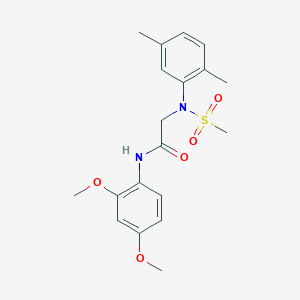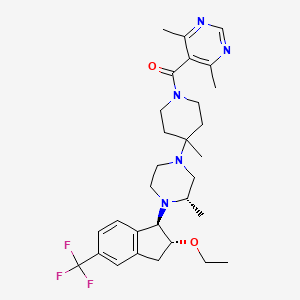
INCB9471
- Click on QUICK INQUIRY to receive a quote from our team of experts.
- With the quality product at a COMPETITIVE price, you can focus more on your research.
Overview
Description
INCB-9471 is a novel, orally available antagonist of the C-C chemokine receptor type 5 (CCR5). It is part of a new class of drugs developed to treat human immunodeficiency virus (HIV) and acquired immunodeficiency syndrome (AIDS). INCB-9471 is a potent and selective inhibitor of the HIV-1 virus, preventing the virus from entering uninfected cells by blocking its predominant entry route, the CCR5 co-receptor .
Preparation Methods
The synthesis of INCB-9471 involves several steps, including the preparation of intermediate compounds and their subsequent reactions to form the final product. The synthetic route typically involves the use of piperazinyl piperidines, which are key intermediates in the synthesis of INCB-9471 . The reaction conditions and specific reagents used in the synthesis are proprietary and have not been fully disclosed in the public domain.
Chemical Reactions Analysis
INCB-9471 undergoes various chemical reactions, including:
Oxidation: This reaction involves the addition of oxygen or the removal of hydrogen from the compound. Common reagents used in oxidation reactions include potassium permanganate and chromium trioxide.
Reduction: This reaction involves the addition of hydrogen or the removal of oxygen from the compound. Common reagents used in reduction reactions include lithium aluminum hydride and sodium borohydride.
Substitution: This reaction involves the replacement of one functional group with another. Common reagents used in substitution reactions include halogens and nucleophiles.
The major products formed from these reactions depend on the specific conditions and reagents used. For example, oxidation of INCB-9471 may result in the formation of a ketone or an aldehyde, while reduction may result in the formation of an alcohol .
Scientific Research Applications
INCB-9471 has several scientific research applications, including:
Chemistry: INCB-9471 is used as a tool compound to study the structure and function of the CCR5 receptor. It is also used in the development of new synthetic methods and reaction conditions.
Biology: INCB-9471 is used to study the role of the CCR5 receptor in various biological processes, including immune cell migration and inflammation.
Medicine: INCB-9471 is being investigated as a potential treatment for HIV and AIDS. .
Industry: INCB-9471 is used in the development of new drugs and therapeutic agents. .
Mechanism of Action
INCB-9471 exerts its effects by binding to the CCR5 receptor, which is a co-receptor for the HIV-1 virus. By blocking the CCR5 receptor, INCB-9471 prevents the virus from entering uninfected cells, thereby inhibiting viral replication and spread. The binding of INCB-9471 to the CCR5 receptor is selective and reversible, and it does not inhibit other receptors, such as CXCR4 .
Comparison with Similar Compounds
INCB-9471 is similar to other CCR5 antagonists, such as maraviroc and vicriviroc. INCB-9471 has several unique features that distinguish it from these compounds:
Selectivity: INCB-9471 is highly selective for the CCR5 receptor and does not inhibit other receptors, such as CXCR4.
Potency: INCB-9471 is a potent inhibitor of the HIV-1 virus, with an inhibitory concentration (IC50) in the nanomolar range.
Oral Availability: INCB-9471 is orally available, making it convenient for use in clinical settings.
Similar compounds include:
Maraviroc: Another CCR5 antagonist used in the treatment of HIV.
Vicriviroc: A CCR5 antagonist that has been investigated for its potential use in the treatment of HIV.
INCB-9471’s unique combination of selectivity, potency, and oral availability makes it a promising candidate for the treatment of HIV and other diseases involving the CCR5 receptor.
Properties
| INCB-9471 is an antagonist of CCR5. It works through a different mechanism of action than currently marketed oral antiviral drugs. Rather than fighting HIV inside a patient's white blood cells, it prevents the virus from entering uninfected cells by blocking its predominant entry route, the CCR5 co-receptor. | |
CAS No. |
869769-98-2 |
Molecular Formula |
C30H40F3N5O2 |
Molecular Weight |
559.7 g/mol |
IUPAC Name |
(4,6-dimethylpyrimidin-5-yl)-[4-[(3S)-4-[(1R,2R)-2-ethoxy-5-(trifluoromethyl)-2,3-dihydro-1H-inden-1-yl]-3-methylpiperazin-1-yl]-4-methylpiperidin-1-yl]methanone |
InChI |
InChI=1S/C30H40F3N5O2/c1-6-40-25-16-22-15-23(30(31,32)33)7-8-24(22)27(25)38-14-13-37(17-19(38)2)29(5)9-11-36(12-10-29)28(39)26-20(3)34-18-35-21(26)4/h7-8,15,18-19,25,27H,6,9-14,16-17H2,1-5H3/t19-,25+,27+/m0/s1 |
InChI Key |
ZMCJFJZOSKEMOM-DNKZPPIMSA-N |
SMILES |
CCOC1CC2=C(C1N3CCN(CC3C)C4(CCN(CC4)C(=O)C5=C(N=CN=C5C)C)C)C=CC(=C2)C(F)(F)F |
Isomeric SMILES |
CCO[C@@H]1CC2=C([C@H]1N3CCN(C[C@@H]3C)C4(CCN(CC4)C(=O)C5=C(N=CN=C5C)C)C)C=CC(=C2)C(F)(F)F |
Canonical SMILES |
CCOC1CC2=C(C1N3CCN(CC3C)C4(CCN(CC4)C(=O)C5=C(N=CN=C5C)C)C)C=CC(=C2)C(F)(F)F |
Origin of Product |
United States |
Retrosynthesis Analysis
AI-Powered Synthesis Planning: Our tool employs the Template_relevance Pistachio, Template_relevance Bkms_metabolic, Template_relevance Pistachio_ringbreaker, Template_relevance Reaxys, Template_relevance Reaxys_biocatalysis model, leveraging a vast database of chemical reactions to predict feasible synthetic routes.
One-Step Synthesis Focus: Specifically designed for one-step synthesis, it provides concise and direct routes for your target compounds, streamlining the synthesis process.
Accurate Predictions: Utilizing the extensive PISTACHIO, BKMS_METABOLIC, PISTACHIO_RINGBREAKER, REAXYS, REAXYS_BIOCATALYSIS database, our tool offers high-accuracy predictions, reflecting the latest in chemical research and data.
Strategy Settings
| Precursor scoring | Relevance Heuristic |
|---|---|
| Min. plausibility | 0.01 |
| Model | Template_relevance |
| Template Set | Pistachio/Bkms_metabolic/Pistachio_ringbreaker/Reaxys/Reaxys_biocatalysis |
| Top-N result to add to graph | 6 |
Feasible Synthetic Routes
Disclaimer and Information on In-Vitro Research Products
Please be aware that all articles and product information presented on BenchChem are intended solely for informational purposes. The products available for purchase on BenchChem are specifically designed for in-vitro studies, which are conducted outside of living organisms. In-vitro studies, derived from the Latin term "in glass," involve experiments performed in controlled laboratory settings using cells or tissues. It is important to note that these products are not categorized as medicines or drugs, and they have not received approval from the FDA for the prevention, treatment, or cure of any medical condition, ailment, or disease. We must emphasize that any form of bodily introduction of these products into humans or animals is strictly prohibited by law. It is essential to adhere to these guidelines to ensure compliance with legal and ethical standards in research and experimentation.


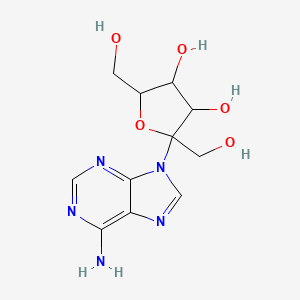
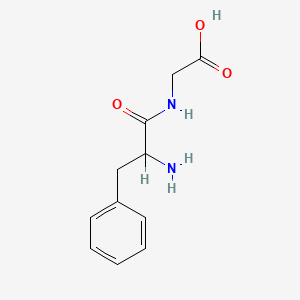
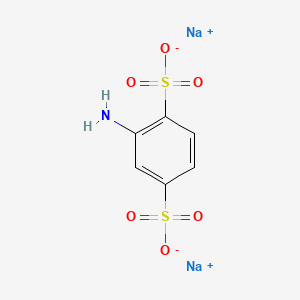
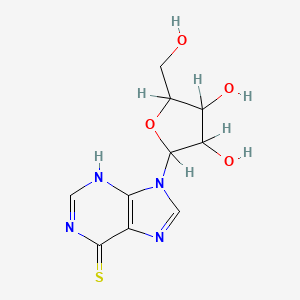
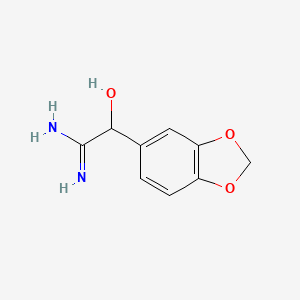

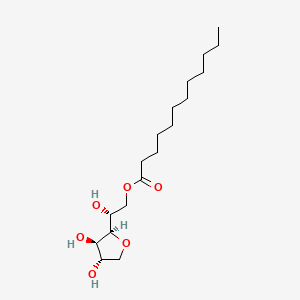

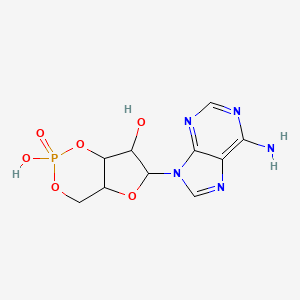
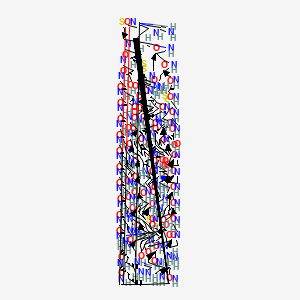

![sodium;[(2R,5R)-2-fluoro-7-oxo-1,6-diazabicyclo[3.2.1]octan-6-yl] sulfate](/img/structure/B3435033.png)
![2-((Z)-1-{4-METHOXY-3-[(3-METHYL-4-NITROPHENOXY)METHYL]PHENYL}METHYLIDENE)-1-HYDRAZINECARBOXAMIDE](/img/structure/B3435037.png)
